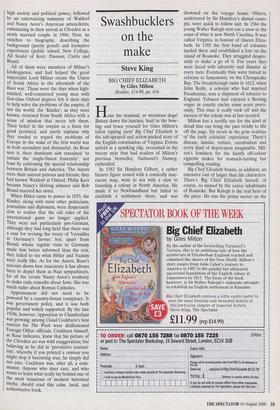Swashbucklers on the make
Steve King
BIG CHIEF ELIZABETH by Giles Milton Hodder, £14.99, pp. 416 Hoist the mainsail, ye mutinous dogs! Batten down the hatches, haul in the bow- line and brace yourself for Giles Milton's latest ripping yarn! Big Chief Elizabeth is the salt-sprayed and action-packed story of the English colonisation of Virginia. Events unfold at a spanking clip, recounted in the breezy style that had readers of Milton's previous bestseller, Nathaniel's Nutmeg, enthralled.
In 1583 Sir Humfrey Gilbert, a rather bizarre figure armed with a comically inac- curate map, went to sea with a view to founding a colony in North America. He made it to Newfoundland but failed to establish a settlement there, and was drowned on the voyage home. Others, undeterred by Sir Humfrey's dismal exam- ple, were quick to follow suit. In 1584 the young Walter Ralegh sent out a crew to the coast of what is now North Carolina. It was called Virginia, in honour of Queen Eliza- beth. In 1585 the first band of colonists landed there and established a fort on the island of Roanoke. They struggled desper- ately to make a go of it. For years they were faced with adversity and disaster at every turn. Eventually they were forced to relocate to Jamestown, on the Chesapeake Bay. The breakthrough came in 1612, when John Rolfe, a colonist who had married Pocahontas, sent a shipment of tobacco to England. Tobacco had enjoyed a fleeting vogue in courtly circles some years previ- ously. This time it really took off and the success of the colony was at last secured.
Milton has a terrific eye for the kind of detail that can bring the past vividly to life off the page. He revels in the grim realities of the early colonists' experience. There's disease, famine, torture, cannibalism and every kind of deprivation imaginable. Mil- ton's fondness for the faintly off-colour vignette makes for stomach-turning but compelling reading.
Big Chief Elizabeth boasts, in addition, an extensive cast of larger than life characters. There's Big Chief Elizabeth herself, of course, so named by the native inhabitants of Roanoke. But Ralegh is the real hero of the piece. He was the prime mover on the administrative side of the colonial enter- prise, and the ups and downs of the colony reflected his own rise and fall at court. The fact that he never so much as set foot in Virginia doesn't bother Milton in the least. He is clearly besotted with the doughty knight, and peppers his tale with anecdotes supporting the popular image of Ralegh as a smooth-talking, cape-doffing. dandy, for- ever exchanging audacious witticisms with the queen or dashing off verses on the remorseless revolution of Fortune's wheel.
Many of the book's other personages are less well known. Milton introduces Ralegh's Oxford chum Thomas Harriot, a brilliant mathematician and linguist whose painstaking efforts to learn the local Indian language did much to speed the colonists' progress. And there is Sir Richard Grenville, the leader of the first and second expeditions to Roanoke. A fearsome man with an explosive temper, Sir Richard would, while drunk, 'take the glasses betweene his teeth and crash them in peeces and swallow them'.
It is a pity that, in the midst of all this swashbuckling fun, Milton did not seize the opportunity to offer more in the way of his- torical perspective or analysis. To have engaged with some of the larger issues raised by the colonisation of Virginia might have greatly enriched the book. But he remains cheerfully unconcerned with any such tiresome donnish stuff. Indeed, he barely pauses to locate this episode in the broader context of 16th- and 17th-century imperial enterprise. Still, the story of how those intrepid and stoical Elizabethan adventurers just kept on keeping on till they got it right is a jolly good one. Big Chief Elizabeth restores a little exotic lustre to even the most familiar and tarnished details of this particular chapter of imperial history.



























































 Previous page
Previous page